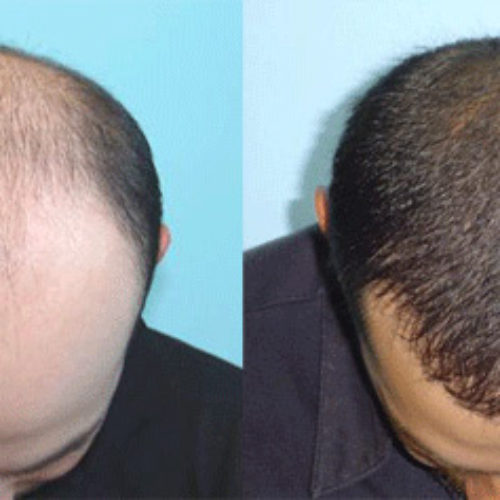Hair Transplant
HAIR TRANSPLANT

Used in the U.S. since the 1950s, hair transplantation is surgery that involves removing a narrow strip of hair-bearing scalp from the back of the head and using it to fill an area with thin or no hair. Most hair transplants are performed in the doctor’s office under local anesthesia. To transplant hair, the surgeon first cleans the scalp, then injects an anesthetic to numb the area where a 3- to 4-inch strip of scalp will be removed. After removing the strip of scalp with a scalpel, the surgeon sets it aside and sews the scalp closed. This area is immediately hidden by the hair around it.
Next, the surgeon divides the strip of removed scalp into approximately 500 to 2,000 tiny grafts containing an individual hair or just a few hairs each. The number and type of graft used depends on the hair type, quality, and color as well as the size of the area where it will be transplanted. After the grafts are prepared, the surgeon cleans and numbs the area where the hair will be placed, creates holes or slits with a scalpel or needle, and delicately places each graft in one of the holes. Depending on the extent of the procedure, the transplant will take approximately four to eight hours. Additional sessions may be needed if you continue to lose hair or decide you want thicker hair.
Expectations and Recovery
After hair transplant surgery, your scalp may be very tender. You may need to take pain medications for several days. Your surgeon will have you wear a surgical dressing over the scalp for at least a day or two. Your surgeon may also prescribe an antibiotic and/or anti-inflammatory drug to be taken for several days following surgery. Most people are able to return to work two to five days after surgery.
Within two to three weeks after surgery, the transplanted hair will fall out, but you should start to notice new growth within a few months. Most people will have attained 60% of new hair growth after six to nine months. Some surgeons prescribe the hair-growing drug minoxidil (Rogaine) to improve hair growth following transplantation, but it is not known how effective this is.
Pre-Procedure
Hair transplantation surgery takes only one day to complete, and is performed on an out-patient basis. You’ll arrive at and go home the same day
- Photos will be taken prior to the hair transplantation surgery to document the extent of your hair loss pre-procedure and to identify the thinning hair areas to be treated. You and your physician will then finalize the details of your procedure goals, using a surgical pen to indicate the treatment areas, hairline location and shape.
- The next step is preparation of the donor area and removal of the donor hair. The clinical team will trim the hair in the donor area, being sure to preserve the surrounding hair with rubber bands so that it will cover the donor area after the procedure.
- The nurse will then administer a local anesthesia to numb the donor area and will ensure that you are completely comfortable during the removal of the donor hair.
- Once the local anesthetic kicks in, the physician will remove the strip of tissue in the donor area at the back and side of the head. These are the permanent, lifelong hair follicles which make permanent hair restoration possible. Once the donor hair is removed, the physician will suture the donor area. The hair that was secured with rubber bands will completely conceal the suture area.
Preparation of the Follicular Units
Once the donor tissue is removed, the clinical staff will begin preparing the follicular units for placement. During this time, patients are typically free to relax and pass the time as they wish. For most this means napping, reading or watching movies. You are free to walk around, chat with the clinical team or use the restroom whenever you want to, while the clinical team prepares the follicular units to begin the next stage of your hair transplant procedure. The trained team will divide the donor strips into their follicle groupings, also known as units. Each unit will be comprised of one, two, three, or four hair follicles.
Creating the recipient sites and placement of the follicular units
Once the follicles are divided and ready to be transplanted, you will receive another round of local anesthesia, administered to the recipient areas. Your hair transplantation physician will then make tiny incisions on your scalp, one for each of the follicular units that will be placed. Detailed attention to the location, angle and depth of each unit is of the utmost importance, as they ensure a natural-looking hairline and results. Natural results demand both clinical expertise and artistic sensitivity, the two hallmarks of hair restoration.
Post Procedure
Once all of the follicular units have been placed, your physician will inspect the newly placed grafts to ensure proper placement. When the hair restoration surgery is complete, your clinical team will provide written and oral post-operative instructions. These include instructions on how to care for your transplant sites, required medication for sleep and any discomfort that you might have, as well as optional medication to take in the days following your hair transplant procedure. We’ll encourage you to sleep with your head elevated with pillows for the first few nights after the procedure.
Persian International Health Tourism is a private company act as a facilitator between patients/visitors, best medical teams and various hospitals suggesting best available options based on your required treatment or other services.








